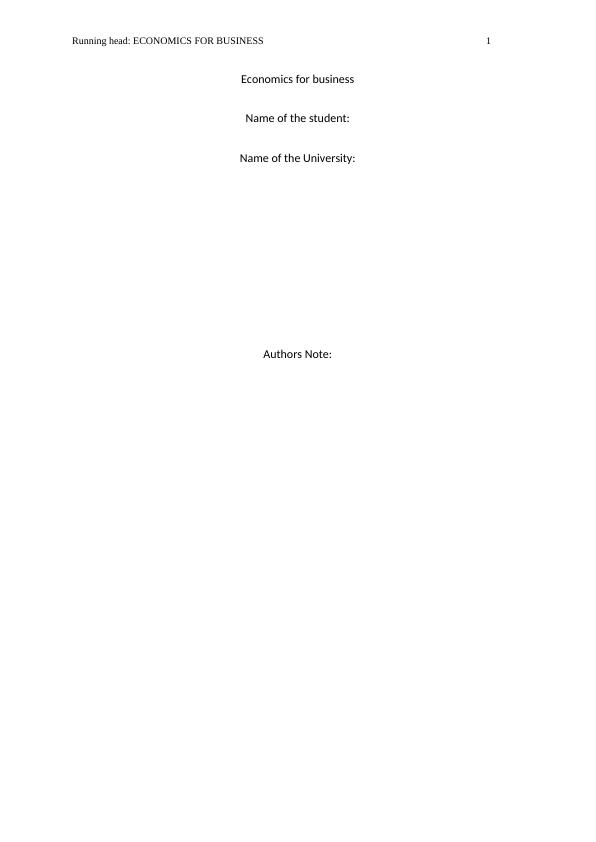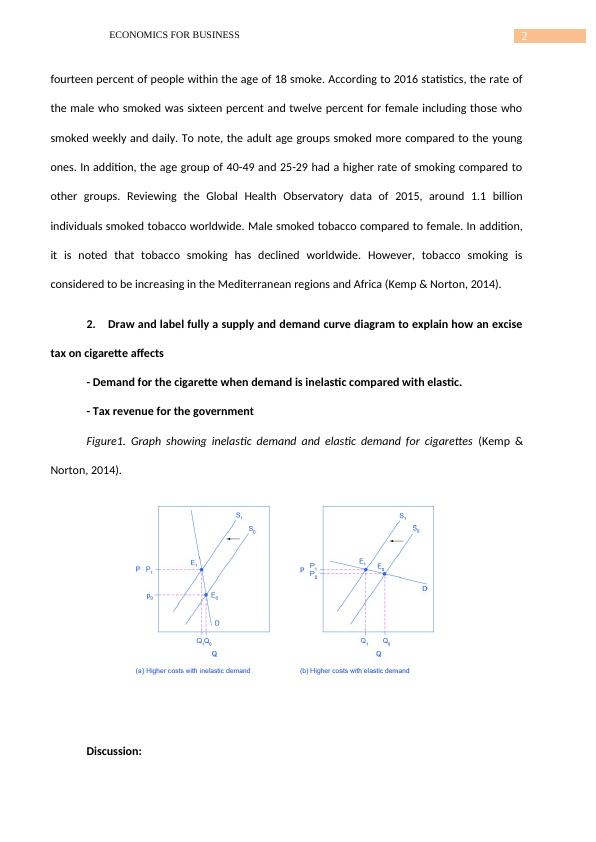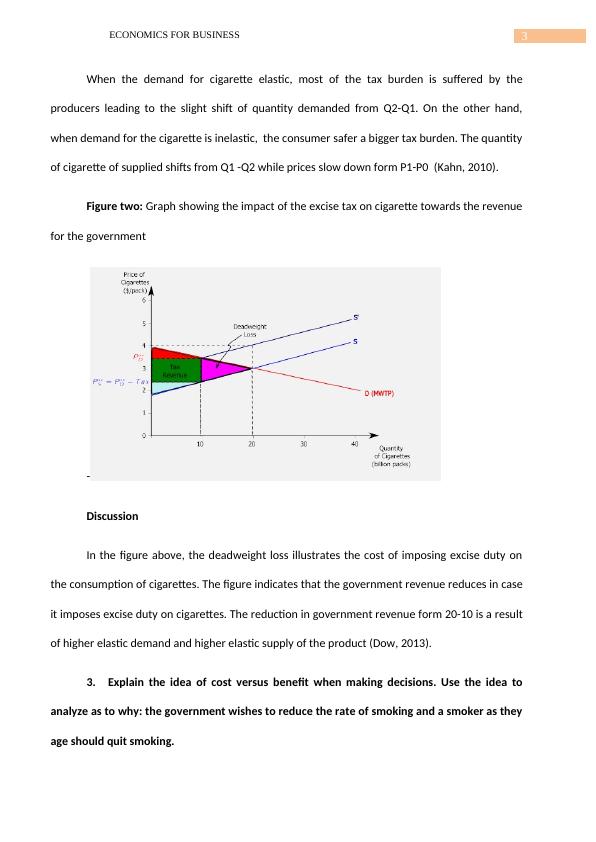Economics for Business: Smoking Rates, Unemployment, and Policies
Added on 2023-06-05
12 Pages3162 Words257 Views
Running head: ECONOMICS FOR BUSINESS 1
Economics for business
Name of the student:
Name of the University:
Authors Note:
Economics for business
Name of the student:
Name of the University:
Authors Note:

1ECONOMICS FOR BUSINESS
Essay 1
1. Compare and contrast the rate of cigarette smoking in Australia with your country
and the world average rate.
For many years, India has been considered among the smoking nations. Smoking in India
is a common sight despite the government efforts trying to discourage it. In India, the habit of
smoking has affected both the young and old. According to reports, around six hundred twenty-
five children in India between the age of ten and fourteen smoke cigarettes daily. Noonan (2016)
noted that over 195,500 girls and 429,500 boys smoked cigarettes in 2015. While compared with
other nations across the world, India has a small percentage of young smokers compared to the
average number of smokers captured from other countries worldwide. To note most of the
cigarette companies have always been targeting the young population of India by using cunning
processes that were used in the United States. It is estimated that over 4,000 Indian women and
13men give every week as a result of long time smoking. In India, smoking is regarded as a public
health problem that requires the government to design measures for protecting the young
generation (Norton, 2012).
According to the Australian welfare and Health institution, smoking in Australia started
way back in 1945. it is estimated that around 14,900 Australian people die every financial year as
a result of smoke-related diseases (Oreopoulos et al., 2012). In addition, Australia always has
four preventable deaths daily. Further, most of the smoking death occurs at the age of sixty-five
compared to India (Cassidy & Parsons, 2017). However, the young generation between the age
of 35 and 64 also die of smoking tobacco. According to records, around seventy-five percent of
people who died in the fiscal year 2004-05 was due to cancer In Australi, lung cancer is
considered to be the most cause of death (Oreopoulos & Petronijevic, 2013). In Australia,
Essay 1
1. Compare and contrast the rate of cigarette smoking in Australia with your country
and the world average rate.
For many years, India has been considered among the smoking nations. Smoking in India
is a common sight despite the government efforts trying to discourage it. In India, the habit of
smoking has affected both the young and old. According to reports, around six hundred twenty-
five children in India between the age of ten and fourteen smoke cigarettes daily. Noonan (2016)
noted that over 195,500 girls and 429,500 boys smoked cigarettes in 2015. While compared with
other nations across the world, India has a small percentage of young smokers compared to the
average number of smokers captured from other countries worldwide. To note most of the
cigarette companies have always been targeting the young population of India by using cunning
processes that were used in the United States. It is estimated that over 4,000 Indian women and
13men give every week as a result of long time smoking. In India, smoking is regarded as a public
health problem that requires the government to design measures for protecting the young
generation (Norton, 2012).
According to the Australian welfare and Health institution, smoking in Australia started
way back in 1945. it is estimated that around 14,900 Australian people die every financial year as
a result of smoke-related diseases (Oreopoulos et al., 2012). In addition, Australia always has
four preventable deaths daily. Further, most of the smoking death occurs at the age of sixty-five
compared to India (Cassidy & Parsons, 2017). However, the young generation between the age
of 35 and 64 also die of smoking tobacco. According to records, around seventy-five percent of
people who died in the fiscal year 2004-05 was due to cancer In Australi, lung cancer is
considered to be the most cause of death (Oreopoulos & Petronijevic, 2013). In Australia,

2ECONOMICS FOR BUSINESS
fourteen percent of people within the age of 18 smoke. According to 2016 statistics, the rate of
the male who smoked was sixteen percent and twelve percent for female including those who
smoked weekly and daily. To note, the adult age groups smoked more compared to the young
ones. In addition, the age group of 40-49 and 25-29 had a higher rate of smoking compared to
other groups. Reviewing the Global Health Observatory data of 2015, around 1.1 billion
individuals smoked tobacco worldwide. Male smoked tobacco compared to female. In addition,
it is noted that tobacco smoking has declined worldwide. However, tobacco smoking is
considered to be increasing in the Mediterranean regions and Africa (Kemp & Norton, 2014).
2. Draw and label fully a supply and demand curve diagram to explain how an excise
tax on cigarette affects
- Demand for the cigarette when demand is inelastic compared with elastic.
- Tax revenue for the government
Figure1. Graph showing inelastic demand and elastic demand for cigarettes (Kemp &
Norton, 2014).
Discussion:
fourteen percent of people within the age of 18 smoke. According to 2016 statistics, the rate of
the male who smoked was sixteen percent and twelve percent for female including those who
smoked weekly and daily. To note, the adult age groups smoked more compared to the young
ones. In addition, the age group of 40-49 and 25-29 had a higher rate of smoking compared to
other groups. Reviewing the Global Health Observatory data of 2015, around 1.1 billion
individuals smoked tobacco worldwide. Male smoked tobacco compared to female. In addition,
it is noted that tobacco smoking has declined worldwide. However, tobacco smoking is
considered to be increasing in the Mediterranean regions and Africa (Kemp & Norton, 2014).
2. Draw and label fully a supply and demand curve diagram to explain how an excise
tax on cigarette affects
- Demand for the cigarette when demand is inelastic compared with elastic.
- Tax revenue for the government
Figure1. Graph showing inelastic demand and elastic demand for cigarettes (Kemp &
Norton, 2014).
Discussion:

3ECONOMICS FOR BUSINESS
When the demand for cigarette elastic, most of the tax burden is suffered by the
producers leading to the slight shift of quantity demanded from Q2-Q1. On the other hand,
when demand for the cigarette is inelastic, the consumer safer a bigger tax burden. The quantity
of cigarette of supplied shifts from Q1 -Q2 while prices slow down form P1-P0 (Kahn, 2010).
Figure two: Graph showing the impact of the excise tax on cigarette towards the revenue
for the government
-
Discussion
In the figure above, the deadweight loss illustrates the cost of imposing excise duty on
the consumption of cigarettes. The figure indicates that the government revenue reduces in case
it imposes excise duty on cigarettes. The reduction in government revenue form 20-10 is a result
of higher elastic demand and higher elastic supply of the product (Dow, 2013).
3. Explain the idea of cost versus benefit when making decisions. Use the idea to
analyze as to why: the government wishes to reduce the rate of smoking and a smoker as they
age should quit smoking.
When the demand for cigarette elastic, most of the tax burden is suffered by the
producers leading to the slight shift of quantity demanded from Q2-Q1. On the other hand,
when demand for the cigarette is inelastic, the consumer safer a bigger tax burden. The quantity
of cigarette of supplied shifts from Q1 -Q2 while prices slow down form P1-P0 (Kahn, 2010).
Figure two: Graph showing the impact of the excise tax on cigarette towards the revenue
for the government
-
Discussion
In the figure above, the deadweight loss illustrates the cost of imposing excise duty on
the consumption of cigarettes. The figure indicates that the government revenue reduces in case
it imposes excise duty on cigarettes. The reduction in government revenue form 20-10 is a result
of higher elastic demand and higher elastic supply of the product (Dow, 2013).
3. Explain the idea of cost versus benefit when making decisions. Use the idea to
analyze as to why: the government wishes to reduce the rate of smoking and a smoker as they
age should quit smoking.

End of preview
Want to access all the pages? Upload your documents or become a member.
Related Documents
Economics for Business: Unemployment and Tobacco Control Measures in Australialg...
|10
|2123
|477
Statistical Analysis on the Bad Impact of Smoking on Students' Physical and Mental Imbalancelg...
|10
|2080
|40
Association between Gender and Lung Cancer Assignmentlg...
|9
|2745
|119
Smoking prevalence in Australia and types of unemploymentlg...
|8
|1379
|102
Analysis of Unemployment and Tobacco Reforms in Australialg...
|11
|1806
|450
Cigarette Smoking and Unemployment Issues in Australia - Economic Analysislg...
|8
|2236
|274
